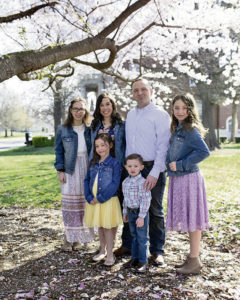JOINT BASE SAN ANTONIO-RANDOLPH, Texas — “I found a leader I could trust,” said Maj. Chris Harmer, as he recounted how fellow wingmen helped him find the support to overcome his invisible wounds.
Harmer left an abusive childhood home and joined the Air Force in 2004 to be part of something larger than himself. He quickly found a new home in the Air Force medical community, and flourished both at work and at home over the next decade. “All felt right in life,” recalls Harmer, along with his wife of 16 years, Shelley. Then the symptoms began.
Living with Invisible Wounds
“The nightmares started around 2013,” Harmer said. A busy father of three and a new flight commander, he started experiencing increased anxiety, nightmares about childhood trauma and triggers around everyday events. “Simple situations like doors slamming or raised voices startled me and became stressful triggers.”
Soon, family life and work began to suffer. Unable to understand or deal with the sudden changes and heightened stressors, Harmer became detached and started feeling inadequate around his children. Trying to learn to be a good father while growing up with an absent one, Harmer felt guilty for not being fully present for his family.

Work also contributed to his increasing sense of failure as small disappointments became significant events that stayed with him. A flare-up of an old back injury around the same time only worsened his downward spiral, preventing him from running to blow off steam and taking an emotional toll as he adjusted to daily pain and limited physical mobility.
With no way to cope with the increased stress, Harmer became isolated and buried himself in work and alcohol.
“I didn’t recognize the person he was becoming,” Shelley recalled. “Chris and I had been inseparable since we were 15 years old; I thought we were set.” They soon stopped spending time with friends and being involved at church, both of which had been a constant source of strength for their family. “All of his hobbies fell away,” Shelley said. “Eventually, he stopped wanting to spend time as a family altogether.”
As a military spouse, Shelley was used to the usual ups and downs of deployments, but they had always been a team. This was different. “I felt hopeless and entirely alone. Nothing I said or did seemed to help him, but I know now that recovery doesn’t work that way.”
Recognizing the Need for Help
Growing up in a physically and emotionally abusive environment had finally caught up with Harmer. Yet he hid the truth from family, friends and fellow wingmen. He felt embarrassed that while fellow Airmen had sustained Post-Traumatic Stress Disorder from deployments, he was dealing with PTSD from childhood trauma unrelated to his career as an Airman.
Friends and family convinced Harmer to attempt professional counseling in 2015, and he sought in-patient treatment in 2016. But it was only a half-hearted effort.
“I never shared the whole truth, never talked about my childhood,” Harmer said. “My heart wasn’t really in it.”
By 2018, he saw no way out. His sense of failure and hopelessness overwhelmed him. “I hadn’t felt hope in my life for a really long time,” Harmer recounted. “I got to a point where after thinking through it logically, I decided my family, wingmen, and others would be better off if I removed myself from the world.”
Road to Recovery
Then, he found a leader he could trust. “When things came to a breaking point, I felt comfortable reaching out because I had witnessed the way the leader had handled prior situations and dealt with challenges,” Harmer recalled.
The leaders within his organization stepped up to engage and support him. They encouraged him to seek treatment and went above and beyond for his family. “They would call Shelley and check in,” Harmer recounted.
Having his leaders behind him, Harmer finally opened up about his childhood trauma and found a trusted support system — wingmen, family, faith leaders and friends. “My life is better today than I ever thought it could be,” Harmer said. While he still occasionally experiences triggers, he has built sustainable practices focusing on mindfulness, health activities and scripture study, and uses the tools he learned in therapy to cope with his invisible wounds.
As Harmer and Shelley reflected on their journey to recovery as a family, they offer the following advice to the Air Force family:
To Airmen: “It’s easy to get off track, but you can get back on track. Find your trusted advocates, whether that’s Airmen, family, leaders, or friends, and tell your story. You have to be willing to ask for help and willing to take a hard look at your behaviors.”
To Caregivers: “Reach out. You feel like you are alone and the only one going through it, but there are so many people going through a similar situation. Talking to someone who understands what you are going through is incredibly helpful. You are never alone!”
To Leaders: “Really talk with your Airmen, check in with them and their families. Make sure they feel heard and seen, so that if and when they ever need to, they know you will be there to support them. The foundation of trust must be set well ahead of the needed intervention.” https://www.woundedwarrior.af.mil/Airmen-Veterans/Invisible-Wounds-Initiative


